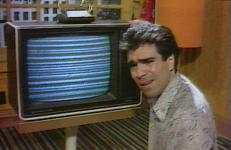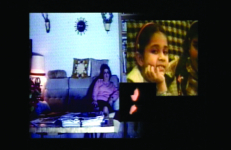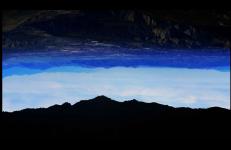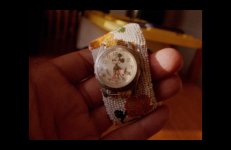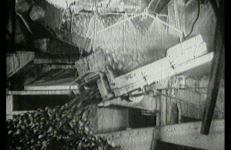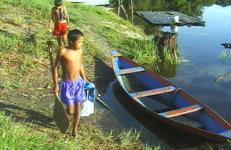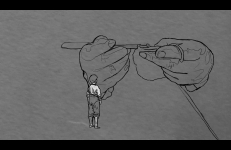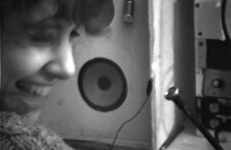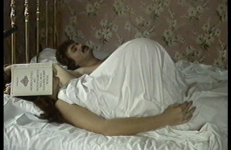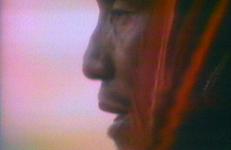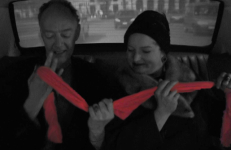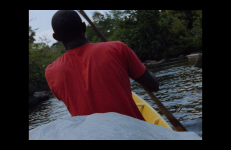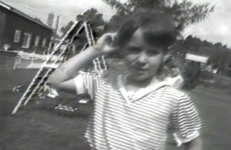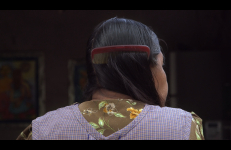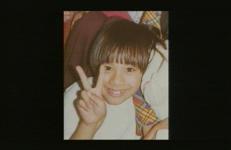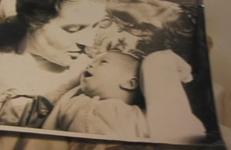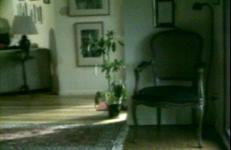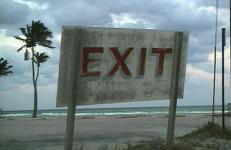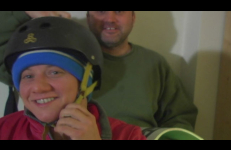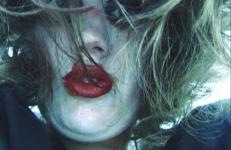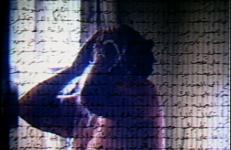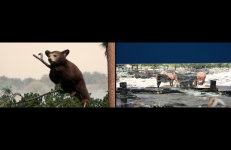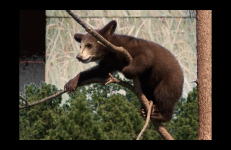Tapping into cable because of his lousy reception, Mike gets more than he bargained for as he unwittingly becomes trapped in the medium—the “star” of his own cable TV show. Due to an incomprehensible mishap, Mike’s rewired TV now transmits his image to the world; the observer has become the observed. Turning the tables on viewership in a way that reflects the banality of television, Smith touches on identification with television, and the manner in which television re-presents our world back to us.
Family
Right after the first Iraq war, the filmmaker visits his family in Iraq. He tries to reconstruct the war from different points of view, all depicted on the same screen at the same time: U.S. airplanes dropping bombs, his parents fixated on the television, and the family welcoming him back.
This title is only available on Radical Closure.
Logging and approximating a relationship between audio recordings of the artist and his father, and videos gathered of the landscapes they both separately traversed. The initial distance between the logger and the recordings, of recollections and of songs, new and traditional, narrows while the images become an expanding semblance of filial affect. Jáaji is a near translation for directly addressing a father in the Hočak language.
This film is a reflection on descendants and ancestors, guided by a 50 year old audio recording of my grandmother learning the Pechanga language from her mother. After being given this tape by my mother, I interviewed her and asked about it, and recorded her ruminations on their lives and her own. The footage is of our chosen home in Whatcom County, Washington, where my family still lives, far from our homelands in Southern California, yet a home nonetheless.
Originally part of a multi-media installation at the Everhart Museum in Scranton, Pennsylvania, King Anthracite documents the lives, work, and early deaths of Lithuanian immigrants (including Kybartas’ ancestors) who mined the Pennsylvania coalfields at the turn of century. Oral histories of miners detail their impressions of the United States and the hardships they encountered, including black lung disease and other occupational hazards that turned wives into widows and children into orphans.
Six Indians of different Waimiri and Atroari villages, located in the Amazon, document the day-to-day life of their relatives in the Cacau village. These images transport us to intimate scenes of their lifestyle and their intense relationship with nature.
Directed and photographed by Araduwá Waimiri, Iawusu Waimiri, Kabaha Waimiri, Sanapyty Atroari, Sawá Waimiri, and Wamé Atroari.
Edited by Leonardo Sette.
In Waimiri and Atroari with English subtitles.
Kiss The Boys And Make Them Die explores how memory, sexuality, and the self are created and enforced through the family story. The video chronicles how the social act of loving women becomes channeled into narratives of incest, desire for the mother, loss of the father, separation from the family, death and self-destruction. In this work, sexuality, difference and language are paralleled with haunting memories of a childhood ghost that both desires and hates women.
La Mesa explores the intersections of memory, identity and queer desire. It recreates fragmented and romanticized stories of a childhood in rural Mexico as told by the artist’s father. These disjointed vignettes are interwoven with queered reenactments of scenes from popular culture. The artist casts himself in the old Mexican films and American Westerns he grew up watching with his family in California. He appears as the romantic lead opposite the male actors, including Pedro Infante, Mexican national hero and the filmmaker’s childhood crush.
"Between March 1972 and February 1977, the Videofreex aired 258 television broadcasts from a home-built studio and jerry-rigged transmitter in an old boarding house they rented in the tiny Catskill Mountain hamlet of Lanesville. It was a revolutionary act in defiance of FCC regulations — the first unlicensed TV station in America."
As Laurie and her child's father lie in bed, taking an afternoon nap, a large balloon resting on her belly inflates under the sheet and explodes. A humorous time-lapse of her developing pregnancy, A late afternoon... suggests a dream she is having about the transformative experience of impending motherhood.
The personal odyssey recorded in The Laughing Alligator combines methods of anthropological research with diaristic essay, mixing objective and subjective vision. Recorded while Downey and his family were living among the Yanomami people of Venezuela, this compelling series of anecdotes tracks his search for an indegenous cultural identity.
While moving through the streets of Paris, a brother and sister confront their incestuous past under the watchful eye of their female taxicab driver. An exploration of vertical montage, this digital video was shot in one long take with live rear-screen projection. English dialogues are adapted from a short story of the same name by Violette Leduc.
"Let Each One Go Where He May is the stunning feature debut of celebrated Chicago-based filmmaker Ben Russell. Having its world premiere in Toronto, the film traces the extensive journey of two unidentified brothers who venture from the outskirts of Paramaribo, Suriname, on land and through rapids, past a Maroon village on the Upper Suriname River, tracing the voyage undertaken by their ancestors, who escaped from slavery at the hands of the Dutch 300 years prior.
A haunting look at the hidden issues of erotic power relationships between women, told through the reconstructed story of two girlhood friends. In Zando’s tape, the origins of desire and domination are traced to the early stages of the childhood relation between mother and daughter, as revealed in the often fearful and cruel framework of childhood play. In the paradigm of need and dependency versus power and control, the submissive impulse is linked to the transcendent yearning to reunite with the pre-natal mother.
The “greca”, the meander, is the main symbol weaved in the textiles made by the Navarro sisters, from Santo Tomás Jalieza, México. A geometrical form of an endless braid of diamonds, the “greca” represents corn (an entity worshiped by the pre-hispanic civilisations of Mesoamerica). It stands for sustenance, but materialises as well the feminine power of producing abundance and fertility - the textiles displaying this ongoing motives could be read as invocations for life and growth.
Which celebrity do you most resemble? For artist Kip Fulbeck, this question starts a rollicking ride that is part autobiography, part family portrait, part pop-culture survey, and all Disney* all the time. Watch as Fulbeck documents his uncanny resemblance to Pochahontas, Mulan, Aladdin, and other "ethnically ambiguous" animated characters. Both hilarious and touching, this educating video examines the muting of race in mainstream media and its effects on multiracial Americans. *Disney is a registered trademark of Disney Enterprises, Inc.
Locke’s Way is the photographic path to knowledge, full of twists and turns, treacherously steep. What has happened down here? A family’s photographs tell us everything and nothing about the subterranean past. "One of the central questions of philosophy has always been: what can be known? Locke’s Way provides a vivid illustration of this perennial philosophical dilemma. In this short video, Donigan Cumming is preoccupied with the story of his older brother, who seems to have been brain-damaged and spent much of his life in institutions.
Treating the problem of anorexia nervosa from the parents' perspective, Rosler presents a mother and father speaking about the tragedy of their daughter's death as a result of dieting. The conversation turns toward the irony of self-starvation in a land of plenty and toward the international politics of food, where food aid is used as a negotiating tool. Confronting a serious issue, Rosler simultaneously sets into play the confessional form and the ghoulish staginess of talk show dramatics.
Loss Prevention combines documentary and fiction to tell the story of Irene, arrested at the age of 79 for stealing a bottle of aspirin from a Miami Wal-Mart and sentenced to ten weeks of Senior Citizen Shoplifting Prevention School. Narrated through the voice of her daughter, this film explores the alienation of aging and the evolving relationship between a daughter and an elderly mother.
LYNDALE is a story of shifting family dynamics, told through the relationship of two brothers. Shot on ten different video formats, this experimental documentary is both the story of a Chicago family, and a record of the digital revolution in the early 2000s. The piece takes place over a six-year period during which filmmakers Oli Rodriguez and Victoria Stob shared a house with Rodriguez’s brother, Jeff.
LYNDALE is a story of shifting family dynamics, told through the relationship of two brothers. Shot on ten different video formats, this experimental documentary is both the story of a Chicago family, and a record of the digital revolution in the early 2000s. The piece takes place over a six-year period during which filmmakers Oli Rodriguez and Victoria Stob shared a house with Rodriguez’s brother, Jeff.
"Mama mama mama...," a woman calls out again and again, over and over. Is it her child that she mimics, or is she calling for her own mother? A desperate video performance in the first person.
In this video, the artist tries to overcome the effects of distance, and reflects on geography represented in exile due to war, and on the psychological distance represented in each one’s approach to her womanhood. The video beautifully weaves personal images and audio recordings of a very intimate nature, binding the personal with the political.
"I’ve been raised with stories of the medicine men in my family. A bundle that was used successfully to heal people. Stories of bear spirits that took care of us. I don’t know about my Scottish side as much, but I did know some of the last names of my ancestors over there. The Sinclairs and the Forsyths. I fell down a Google rabbit hole one day when the Survey of Scottish Witchcraft came out. There was one case with a last name and a location close to my Great Grandmother’s hometown that made me pause. It was a white magic case, protecting cattle, and talking with fairies.
Medicine Bundle is about a bundle that was used in my family to heal my Great Great Grandfather from a smallpox epidemic and a life threatening wound from a gatling gun used against him during the Battle Of Cutknife Hill in 1885. The bundle was again used in 1918 when my Grandfather contracted the Spanish Flu as a baby. It was buried in an unmarked grave to protect it from grave robbers, but the spirit within the bundle has continued to protect our family from more modern psychological effects of colonization like depression.




